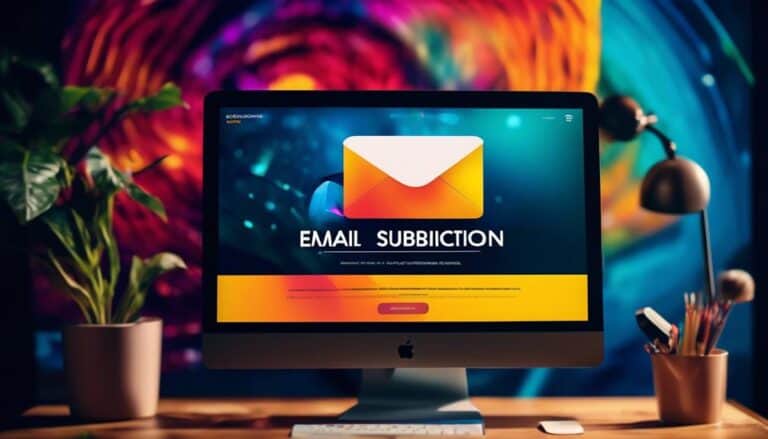Quick Action Needed: Implement Cutting-Edge Personalization in Your Emails Today
Are your email campaigns falling flat? Are you struggling to engage your subscribers and drive conversions? It's time to take action and implement cutting-edge personalization in your emails.
Imagine this: you send an email to a customer who recently purchased a pair of running shoes. Instead of a generic message, you greet them by name and recommend complementary products based on their past purchases. Sounds intriguing, right?
In this discussion, we will explore the power of personalization and how it can revolutionize your email marketing strategy. So, let's dive in and discover the secrets to creating impactful, personalized emails that captivate your audience and drive results.
Key Takeaways
- Personalization in email marketing campaigns is crucial for higher engagement and conversions.
- Understanding your audience's preferences, behaviors, and needs is essential for effective personalization.
- Collecting and analyzing relevant data enables highly personalized email campaigns.
- Segmenting your email list based on demographics, interests, and previous interactions allows for targeted and personalized content.
The Power of Personalization

Personalization in email has the power to revolutionize your marketing campaigns, driving higher engagement and conversions by delivering tailored content directly to your audience's inbox. By leveraging the benefits of personalization, you can create a unique and individualized experience for each of your subscribers, making them feel seen, understood, and valued.
One of the key benefits of personalization is increased engagement. When you send personalized emails, you're able to cater to the specific interests and preferences of your audience. By delivering content that's relevant to them, you capture their attention and encourage them to take action. According to a study by Experian, personalized emails have 29% higher open rates and 41% higher click-through rates compared to generic emails. This means that personalization not only grabs your audience's attention but also motivates them to interact with your brand.
However, implementing personalization in email does come with its challenges. One of the main challenges is collecting and managing the necessary data. To deliver personalized content, you need to gather information about your subscribers, such as their name, location, and past interactions with your brand. This requires a robust data collection system and a well-organized database. Additionally, maintaining the accuracy and relevancy of the collected data can be a challenge, as people's preferences and circumstances change over time.
Understanding Your Audience
To create effective personalized email campaigns, it is crucial to have a deep understanding of your audience's preferences, behaviors, and needs. Audience profiling plays a vital role in this process, allowing you to tailor your messages to resonate with your target customers. By collecting and analyzing data on their demographics, interests, and past interactions, you can gain valuable insights that inform your personalization techniques.
To illustrate the importance of audience understanding, consider the following table:
| Preference | Behavior | Need |
|---|---|---|
| Time | Opens emails | Productivity |
| Discounts | Clicks on CTAs | Savings |
| Relevance | Shares content | Relevance |
| Personalization | Engages with surveys | Customization |
| Quality | Responds to offers | Satisfaction |
Collecting Relevant Data

By gathering and analyzing relevant data, you can gain valuable insights into your audience's preferences and behaviors, enabling you to create highly personalized email campaigns. Here are some effective data collection techniques to help you gather the information you need:
- Surveys: Implementing surveys allows you to directly ask your audience about their preferences, interests, and needs. Keep the questions concise and relevant to encourage participation.
- Website Analytics: Utilize website analytics tools to track user behavior, such as pages visited, time spent on each page, and click-through rates. This data can reveal valuable insights into what your audience finds engaging.
- Purchase History: Analyzing your audience's purchase history can provide insights into their buying patterns and preferences. This information can help you tailor your email campaigns to their specific needs.
- Social Media Listening: Monitor social media platforms to understand what your audience is saying about your brand and their interests. This can help you identify trends and topics that resonate with them.
- Email Engagement Tracking: Track email open rates, click-through rates, and conversions to understand how your audience interacts with your emails. This data can help you refine your messaging and optimize your campaigns for better results.
While data collection techniques are crucial for personalization, it's important to address data privacy concerns. Ensure you're transparent about how you collect and use data, and obtain consent from your audience. Respecting their privacy builds trust and strengthens your relationship with them.
Segmenting Your Email List
Segmenting your email list is crucial for running targeted email campaigns and creating personalized content. By dividing your subscribers into different segments based on factors such as demographics, interests, and previous interactions, you can send tailored messages that resonate with each group.
This level of personalization not only increases engagement but also improves conversion rates, resulting in a more successful email marketing strategy.
Targeted Email Campaigns
Increase the effectiveness of your email campaigns by strategically segmenting your email list based on customer preferences and behaviors. Targeted email campaigns allow you to deliver personalized messages that resonate with your audience, resulting in higher engagement and conversion rates.
Here are five reasons why segmenting your email list is crucial for successful email marketing:
- Improved Open Rates: By sending tailored messages to specific segments, you can capture the attention of your subscribers and increase open rates.
- Higher Click-Through Rates: Targeted messaging ensures that your subscribers receive content that's relevant to their interests, increasing the likelihood of them clicking on your emails.
- Enhanced Customer Experience: Personalization techniques such as using the recipient's name or referencing their previous purchases make your emails feel more personal and show that you value their business.
- Increased Revenue: When you provide relevant offers and recommendations to your customers, you're more likely to drive conversions and boost your revenue.
- Reduced Unsubscribes: By sending targeted emails, you can avoid bombarding your subscribers with irrelevant content, reducing the likelihood of them unsubscribing.
Segmenting your email list allows you to deliver personalized and relevant content to your subscribers, resulting in improved open rates, higher click-through rates, and increased revenue. Start implementing targeted email campaigns today and see the positive impact it has on your email marketing efforts.
Personalized Content Creation
Personalized content creation is essential for maximizing the impact of your email marketing campaigns and driving higher engagement rates. By segmenting your email list and creating personalized email templates, you can deliver targeted messages that resonate with your audience's specific needs and interests. This level of data-driven personalization not only increases open rates and click-through rates but also helps to build stronger relationships with your subscribers.
To effectively segment your email list, consider using the following criteria:
| Criteria | Examples |
|---|---|
| Demographics | Age, gender, location |
| Behavior | Purchase history, website activity |
| Interests | Product preferences, content engagement |
Dynamic Content Creation

By tailoring your email content to individual recipients, you can create a highly engaging and relevant experience that resonates with your audience. Dynamic content creation allows you to take personalization a step further, enabling you to deliver real-time and data-driven personalization that grabs the attention of your subscribers.
Here are five key benefits of implementing dynamic content creation in your emails:
- Increased engagement: By delivering personalized content that's tailored to each recipient's preferences and interests, you can capture their attention and keep them engaged with your emails.
- Improved relevancy: Dynamic content creation allows you to serve up the most relevant information to each subscriber, ensuring that your emails are valuable and meaningful to them.
- Higher conversion rates: Personalized emails have been proven to drive higher conversion rates. By using dynamic content creation, you can deliver targeted messaging that speaks directly to your subscribers' needs and motivations, leading to increased conversions.
- Enhanced customer experience: When you provide personalized and relevant content, you show your subscribers that you understand their preferences and care about their needs. This helps to create a positive and memorable experience that builds customer loyalty.
- Better ROI: By delivering personalized and relevant content that resonates with your audience, you can achieve higher ROI on your email marketing efforts. Personalization has been shown to drive revenue, and dynamic content creation takes this to the next level by delivering real-time and data-driven personalization.
Don't miss out on the opportunity to leverage dynamic content creation in your email marketing strategy. Start implementing it today and see the positive impact it can have on your engagement, conversions, customer experience, and ROI.
Tailoring Subject Lines and Preheaders
Are your email subject lines falling flat?
Are your preheaders being ignored?
It's time to take your personalization efforts to the next level by tailoring your subject lines and preheaders.
Research shows that personalized subject lines can increase open rates by up to 50%.
By customizing your preheader text, you can provide a compelling preview of your email content, enticing recipients to open and engage with your message.
Don't miss out on the opportunity to make a strong first impression and drive higher engagement with personalized subject lines and preheaders.
Personalized Email Subject Lines
To enhance the effectiveness of your email campaigns, consider tailoring subject lines and preheaders to captivate your audience from the very first glance. Personalized subject lines can significantly increase open rates and engagement. Here are some strategies to help you create compelling subject lines:
- Use the recipient's name: Addressing your audience by name adds a personal touch and grabs their attention.
- Leverage location data: Incorporate the recipient's location in the subject line to make it more relevant and targeted.
- Create a sense of urgency: Use phrases like 'Limited Time Offer' or 'Last Chance' to encourage immediate action.
- Ask a question: Pose a thought-provoking question to pique curiosity and entice recipients to open the email.
- Use emojis: Emojis can add visual appeal and convey emotions, making your subject line stand out in a crowded inbox.
Customized Preheader Text
To continue optimizing your email campaigns, consider tailoring your preheader text alongside personalized subject lines to fully capture your audience's attention and drive engagement. Customized preheader text can significantly impact open rates and click-through rates.
It's the short preview text that appears after the subject line in an email inbox. By personalizing this text, you can provide a compelling reason for your audience to open your email. Use this space to highlight the key benefits or offers within your email content.
For example, you can mention exclusive discounts, limited-time promotions, or personalized recommendations. By incorporating customized preheader text into your email templates, you can increase the effectiveness of your email campaigns and deliver a more personalized experience to your subscribers.
Tailoring Email Content
By tailoring your email content, specifically your subject lines and preheaders, you can effectively capture your audience's attention and drive higher engagement rates. Here are five reasons why tailoring your email content is crucial for success:
- Personalized subject lines grab attention: Including the recipient's name or referencing their recent activity can significantly increase open rates.
- Segmented subject lines boost relevance: Segmenting your audience based on demographics or interests allows you to create subject lines that resonate with specific groups.
- Preheaders provide additional context: Use preheaders to complement your subject line and provide a compelling preview of the email's content.
- Customized preheaders improve open rates: Including personalized information in the preheader can entice recipients to open your email.
- Relevant content leads to higher engagement: Tailoring your email content to match the recipient's preferences and needs enhances the likelihood of click-throughs and conversions.
Triggered Emails for Real-Time Engagement
Incorporate real-time engagement into your email strategy with triggered emails for personalized interactions. By leveraging real-time analytics and personalized recommendations, you can deliver highly relevant content to your subscribers at the right moment. This not only increases engagement but also boosts conversions and drives customer loyalty.
One powerful way to implement real-time engagement is through triggered emails. These emails are automatically sent based on specific actions or events, allowing you to deliver timely and personalized messages. For example, when a customer abandons their shopping cart, you can send them a triggered email with a personalized offer to entice them to complete their purchase.
To illustrate the impact of triggered emails, consider the following data:
| Trigger Event | Email Open Rate | Click-Through Rate | Conversion Rate |
|---|---|---|---|
| Abandoned Cart | 50% | 25% | 10% |
| Product Back In Stock | 60% | 30% | 12% |
| Birthday | 70% | 35% | 15% |
| Order Confirmation | 80% | 40% | 18% |
| Welcome | 90% | 45% | 20% |
As you can see, triggered emails have significantly higher engagement and conversion rates compared to traditional email campaigns. By incorporating real-time engagement strategies, you can provide personalized experiences that resonate with your audience, resulting in increased customer satisfaction and long-term success. Don't miss out on the opportunity to take your email marketing to the next level with triggered emails.
Testing and Optimization Strategies

Maximize the effectiveness of your email campaigns with robust testing and optimization strategies that drive engagement and conversions. Testing and optimization are crucial elements in ensuring your emails are performing at their best.
Here are five strategies you can implement today to optimize your email campaigns:
- Utilize A/B testing techniques: Experiment with different subject lines, email designs, and calls-to-action to determine which variations resonate best with your audience. This data-driven approach allows you to make informed decisions that improve open rates, click-through rates, and ultimately, conversions.
- Segment your audience: Tailoring your emails based on your subscribers' preferences, behavior, and demographics boosts engagement and increases the chances of conversion. Personalization creates a sense of individual attention, making your subscribers feel valued and understood.
- Optimize for mobile devices: With the majority of emails being opened on mobile devices, it's crucial to ensure your emails are mobile-friendly. Optimize your email design, font sizes, and call-to-action buttons to provide a seamless experience for your mobile users.
- Test email timing: Experiment with different sending times to determine the optimal time to reach your audience. Consider factors such as time zones, industry benchmarks, and your subscribers' habits to improve open rates and engagement.
- Monitor and analyze metrics: Keep a close eye on key metrics such as open rates, click-through rates, and conversion rates. Analyze the data to identify trends, patterns, and areas for improvement. By constantly monitoring and optimizing your campaigns, you can continuously enhance your conversion rate optimization efforts.
Tracking and Analyzing Performance
Are you tracking and analyzing the performance of your email campaigns to drive better results? Tracking trends and analyzing data are crucial steps in improving the effectiveness of your email marketing strategy. By understanding how your emails are performing, you can make data-driven decisions to optimize your campaigns and achieve better engagement and conversion rates.
To track and analyze the performance of your email campaigns, you need to focus on key metrics such as open rates, click-through rates (CTRs), and conversion rates. These metrics provide valuable insights into the effectiveness of your emails and help you identify areas for improvement. Let's take a look at the following table to understand how these metrics can be used to track and analyze the performance of your email campaigns:
| Metric | Definition | Importance |
|---|---|---|
| Open Rate | The percentage of recipients who open | Indicates the effectiveness of your |
| your email | subject lines and email preview | |
| Click-Through | The percentage of recipients who click | Measures the relevance and appeal of |
| Rate (CTR) | on a link within your email | your email content |
| Conversion Rate | The percentage of recipients who take | Reflects the success of your call-to- |
| the desired action (e.g., making a purchase) | action and overall campaign effectiveness |
By monitoring these metrics and analyzing the data, you can identify trends, spot areas of improvement, and make data-driven decisions to optimize your email campaigns. For example, if you notice a low open rate, you can experiment with different subject lines to increase engagement. Similarly, if your click-through rate is low, you can focus on improving the content and calls-to-action in your emails.
Tracking and analyzing the performance of your email campaigns is essential to continuously improve your email marketing strategy. By leveraging data and making informed decisions, you can drive better results and better serve your audience. So, don't overlook the power of tracking and analyzing your email performance – it's the key to unlocking the full potential of your campaigns.
Frequently Asked Questions
How Can I Ensure That My Personalized Emails Are Not Perceived as Intrusive or Too Intrusive by My Audience?
To ensure your personalized emails aren't perceived as intrusive, focus on building trust. Implement personalization strategies that make recipients feel valued and understood. Use data-driven insights to deliver relevant content that genuinely serves their needs.
What Are Some Best Practices for Collecting and Organizing Relevant Data for Effective Personalization?
To effectively personalize your emails, focus on data collection strategies and effective data organization. By gathering relevant information about your audience and organizing it properly, you can tailor your messages for maximum impact.
Are There Any Specific Tools or Software That Can Assist With Segmenting and Targeting My Email List?
Segmentation tools and targeting software can greatly assist in optimizing your email list. These tools allow you to divide your audience into specific segments and deliver personalized content, resulting in higher engagement and conversion rates.
What Are Some Creative Ways to Create Dynamic Content That Resonates With Individual Recipients?
To create dynamic content that resonates with individual recipients, use creative strategies like personalized subject lines, dynamic product recommendations, and tailored messaging based on their preferences and behavior. These personalization tips will boost engagement and drive conversions.
How Can I Measure the Success and Effectiveness of My Personalized Email Campaigns?
To measure the effectiveness of your personalized email campaigns, you can use A/B testing. This allows you to compare different versions of your emails and see which one performs better, giving you valuable data to optimize your campaigns.
Conclusion
Don't miss out on the incredible benefits of personalization in your email marketing. By understanding your audience, collecting relevant data, and segmenting your email list, you can create tailored content that resonates with each individual recipient.
Dynamic content creation, personalized subject lines, and triggered emails further enhance engagement. Test, optimize, and track your performance to continuously improve your results.
With cutting-edge personalization, you'll see higher open rates, click-through rates, and conversions. Start implementing these strategies today and stay ahead of the competition.







